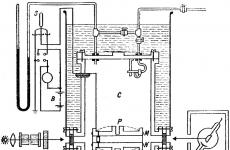Construction of country houses from aerated concrete blocks: technology features and prices. Aerated concrete floor slabs Projects and prices of turnkey aerated concrete houses
Aerated concrete is an artificial stone that has recently been used in the construction world. It has high thermal conductivity and strength, is light and easy to install, and has found its application in the construction of partition and wall blocks. Due to the exact parameters of aerated concrete floors, an even and smooth coating is provided, which does not require subsequent finishing. Aerated concrete walls are prefabricated prefabricated slabs. Great demand for such products has arisen because of their environmentally friendly components that do not affect human health.
Where are they used?
Aerated concrete slabs are used in the installation of floors between the floors of buildings, and also serve for the construction of walls. Aerated concrete structures are used in the construction of houses, the height of which does not exceed three floors. For floors, aerated concrete blocks are used with technical characteristics suitable for the weight of the vaults.
Dignity
- Aerated concrete blocks have no dimensional errors. Thanks to this, the surface is flat, which significantly reduces the cost of finishing buildings. But there is one condition - the walls must also be free of reliefs, cracks and potholes. To get rid of defects, putty and sanding are used.
- Mounting an aerated concrete slab, you do not have to spend a lot of time, make great efforts.
- The advantages of this material include the lightness of the blocks, which during operation do not exert a load on the load-bearing walls of buildings.
- When installing aerated concrete elements, a small amount of auxiliary equipment is used.
- When using aerated concrete in the construction of houses with a small number of floors, the following material characteristics are taken into account: strength, fire resistance, sound insulation, thermal insulation and moisture resistance. The material is odorless, with environmentally friendly components.
- The advantage when working with aerated concrete floors is their convenience when installing balcony bases.
disadvantages

Main types
Aerated concrete building blocks are autoclaved and non-autoclaved. The second type is the best in terms of price and quality characteristics. When using autoclave cookers, you need to be prepared that after installation, during operation, they "age". In the production of autoclaved aerated concrete slabs, lime is used, due to which the materials harden as a result of pressure and temperature. In the preparation, cement is used as a binder; as a result, the hardening of the particles occurs naturally.
Floor slabs for aerated concrete are of the following types:
- monolithic;
- aerated concrete;
- wooden beams;
- reinforced concrete slabs;
- metal beams.
 When using aerated concrete slabs, a reinforced annular belt must be installed.
When using aerated concrete slabs, a reinforced annular belt must be installed. The overlap of iron or aerated concrete is a monolithic structure consisting of grooves into which slabs are inserted. When working with aerated concrete slabs, they are laid on a reinforcing layer. In this case, the reinforcing structure is treated with anti-corrosion coatings..
The dimensions of the slabs are different, but the main condition is that they should protrude 20 cm beyond the span. Also, prefabricated ones are used, the manufacture of which takes place at factories; they are more economical than monolithic ones. Aerated concrete structures differ in light weight, which cannot be said about reinforced concrete ones.
Monolithic ceilings with a thickness of about 3 centimeters include a reinforcing mesh, poured with concrete. Such structures of aerated concrete houses have a different shape than are not similar to slabs. Single ceilings endure a large load, which is a plus, the disadvantages include their high cost and labor intensity.
There are also prefabricated monolithic structures, including prefabricated aerated concrete floors, the top of which is reinforced.
They are installed a couple of centimeters below the floors to avoid pressure and cracking. Aerated concrete floor slabs can act as door and window lintels. With a wall thickness of more than 5 cm, prefabricated jumpers are used, the length of which should be 1 centimeter greater than the opening.
Aerated concrete, used in the production of blocks for the construction of houses, has high thermal insulation properties. However, in difficult weather conditions, additional insulation will not be superfluous.
How do you know if insulation is required?
- If the used aerated concrete has a density of D500, the wall thickness of the house does not exceed 300 mm, it is necessary to carry out insulation.
- Cement mortar was used as an adhesive for aerated concrete blocks. This material does not have the required thermal insulation properties.
Manipulations are performed first in the inner part of the house, only then the house is insulated from aerated concrete from the outside. The comfortable temperature in the room depends on the thickness of the insulation layer. The optimal insulating layer is 10 cm.
Insulation methods:
- Internal placement of insulation can reduce the useful living space by at least a little. In the process, a ventilation system is required. Otherwise, mold may appear on the walls, and a fungus may develop between the layers of insulation.
- Insulation of a house from aerated concrete from the outside is carried out more often. Residents note the good heat and sound insulation qualities of the insulation. A layer of insulation protects the wall of the house from the damaging effects of moisture.
How to insulate a house from aerated concrete?
The most popular insulation options are:
- Mineral wool.
- Expanded polystyrene.
Mineral wool insulation
The material is durable, has a high vapor permeability. The use of mineral wool as insulation will provide a comfortable temperature and moisture balance in the room.
The service life of the material is 70 years. Mineral wool is more practical than expanded polystyrene. Available in slabs and rolls. Plates 50x100 cm in size are considered the most convenient to install.
Work order:
- External walls are cleaned of dirt and dust with a brush and a metal sponge.
- The insulation is glued using special glue.
- The material is additionally fixed with plastic dowels.
- Once dry, a fiberglass mesh is attached to the wall to protect the structure from cracks in the plaster and paint.
- Another layer of glue is applied over the mesh.
- After the glue has completely dried, plaster the wall.
Advantages and disadvantages of warming a house made of aerated concrete with mineral wool
Pros:
- The room warms up quickly.
- Cools down slowly.
- Condensation does not accumulate on the surface of the outer walls.
Minuses:
- High cost of insulating material.
Warming with expanded polystyrene
Economical insulating material. Can only be used outside buildings. There are two types of expanded polystyrene - expanded polystyrene and expanded polystyrene.
The cost of expanded polystyrene is much lower than the price of mineral wool. This material is vapor and moisture resistant. Aerated concrete houses with foam insulation must be supplemented with additional ventilation holes.

Styrofoam is attached to the wall with glue, and then additionally secured with plastic dowels. Plastering and painting of walls is carried out after the glue layer has completely dried.
Work order:
- The walls of the house are cleaned of gaps, dust and dirt.
- Cracks are plastered.
- The surface of the walls is primed.
- After the primer layer has completely dried, the insulation is glued.
- From above, the insulating layer is additionally attached with dowels.
- At the end, they are finished with plaster or siding.
Insulation of a house from aerated concrete for siding
This type of finishing can be performed both with mineral wool and with expanded polystyrene plates. Siding is an additional insulating layer. The advantages of this type of finishing:
- Improving the sound insulation of the walls.
- Reducing the cost of heating the premises.
- Easy to care for.
- Aesthetic appeal.
- Long service life of the material and the absence of deformation with strict adherence to the installation rules.
- Affordable cost of materials.
- The structure is lightweight, so the load on the building facade is minimal.
- Siding differs in non-combustible properties, resistant to weathering, fading.
- Can be installed on buildings of any configuration.
Thermal insulation of aerated concrete walls with front panels
An excellent option for wall insulation is the use of front thermal panels made of hard polyurethane, decorated with clinker tiles.

They are used in the construction of ventilated facades - thus, the walls of the house are protected from external influences and from the winds, but do not form an unnecessary barrier and maintain the required vapor permeability of the entire wall. The principle "from the inside - out" when using these facade panels is fully respected.
With the practical absence of visible disadvantages, they immediately have a number of positive qualities:
- Provides reliable wind protection
- Have a minimum thermal conductivity of 0.021 W / (m * L)
- Completely harmless to humans, animals and the environment
- Rigid polyurethane panels last 20 to 40 years
- Reinforced with a metal profile for durability
- The total weight of the structure is reduced by 30% compared to analogs
Conclusion
Aerated concrete is an excellent material for the construction of buildings and structures. Houses from it are warm, reliable. However, to improve energy-saving qualities, any building needs to be insulated.
Mineral wool is recognized as the best insulating material. Expanded polystyrene also has good properties. Compliance with the technology of insulation will provide a comfortable temperature in the house and increase the service life of the structure for many years.































Aerated concrete is a stumbling block in a considerable number of construction disputes. Despite the battles, many professional builders believe that it is a good, if not perfect, building material. As, however, and all the others. To decide to build a house from aerated concrete blocks, one must remember that the material has many useful qualities, has already become quite widespread.

The choice of wall aerated concrete (gas silicate) blocks Source stroyres.net
A bit of history
For centuries, people have used a natural building stone - tuff for the construction of houses. It was appreciated for its lightness, ease of processing and its ability to retain heat well. Since the 19th century, scientists have tried to reproduce these qualities by experimenting with concrete mixes. The consistent work of several researchers is considered to be important milestones on the path of creating modern aerated concrete:
Engineer Hoffmann(Czech). In 1889, he conducted a series of experiments with cement mortar, adding acids and salts to it. In the process of solidification, the evolved gases formed a characteristic porous structure.
Americans Aulsworth and Dyer... In 1914, they were the first to use aluminum and zinc salts. The reaction proceeded with the evolution of hydrogen, which formed a homogeneous porous structure. The method laid the foundation for the future technology.
Architect Erickson... In 1922, the Swede patented a method for the production of aerated concrete using aluminum powder, becoming the godfather of modern autoclaved aerated concrete. The first aerated concrete for the construction of industrial and residential buildings began to be produced in 1929.

Modern project of a house made of gas silicate blocks Source buildhouse.info
In the USSR, the industrial production of aerated concrete was also established in the 30s. The first autoclaved block aerated concrete was produced in Riga, in 1937; the city still has buildings erected from these blocks. In the post-war 50s, aerated concrete helped to restore the destroyed infrastructure, both in the USSR and in Europe. In modern Russia, the needs for material are satisfied by more than 80 modern manufacturing plants.
Composition and technology
Aerated concrete is a representative of the category of aerated concrete, building materials, different in properties and features of operation. The unifying characteristics are porous structure, low weight and low density. In the production of aerated concrete, the following components are used:
Astringent... Portland cement.
Filler... Quartz sand.
Gasifier... Aluminum powder or paste.
Industrial cleaning water.
Improving Supplements... Lime, gypsum, industrial waste (slag, ash).

Autoclave blocks Source ar.decorexpro.com
Aerated concrete production begins with mixing the ingredients and pouring the mixture into molds. The chemical reaction leads to the formation of hydrogen. The gas increases the volume of the mixture (swells it) and forms pores. After the end of the reaction, the mixture is set, it is removed from the molds and cut according to the standard. Further processing goes in two ways. Depending on which drying method is used, one of two types of aerated concrete is obtained:
Autoclave(synthesis) hardening. The blocks are hardened (steamed) in autoclaves (devices that create high pressure in an environment saturated with water vapor).
Non-autoclave(hydration, air) hardening. The blocks are hardened at atmospheric pressure in drying chambers.
Classification
According to the standard, cellular concretes (including aerated concrete) are divided into three types according to their functional purpose:
Structural... Density ranges from 1000–1200 kg / m³.
Structural and thermal insulation... From 500 to 900 kg / m³. The D500 brand says that in 1 m³ part of the volume is filled with 500 kg of solid material, the remaining volume is air that fills the voids (cells).
Heat insulating... From 200 to 500 kg / m³.

Using blocks increases the construction speed Source geo-comfort.ru
Specifications
Aerated concrete serves as an example of the optimal balance between the main performance characteristics:
Durability... Despite the low density (specific gravity), the strength is sufficient for the use of aerated concrete in the construction of load-bearing walls.
Ease... The lightness of aerated concrete is due to its porosity, which can reach 85-90% of the volume of the material.
Low thermal conductivity... Good thermal efficiency is also a result of the porosity of the material. Aerated concrete boasts the lowest thermal conductivity coefficient, 0.12 W / m ° С (in dry state).
Handicraft mistakes
Having found on the Internet many tips for the production of aerated concrete with their own hands, and making sure that they are quite feasible, many decide to start their own production. At the same time, home craftsmen do not consider it necessary to strictly adhere to technological standards, but they always find people willing to purchase a product at dumping prices.

Small-scale production - no guarantee Source beton-house.com
On our website you can familiarize yourself with the most popular projects of houses made of aerated concrete blocks from construction companies presented at the exhibition of houses "Low-rise Country".
The use of high-quality raw materials and technological equipment in factory production makes it possible to obtain aerated concrete products with stable physical and chemical characteristics:
Exact dimensions and correct, with minimal marriage, shape.
Specified physical and mechanical parameters.
Uniform material density, which is confirmed visually (uniform distribution of air cavities).
Chemical inertness of the material, which is confirmed by laboratory control throughout the production cycle.
The conditions of handicraft production cannot provide manufacturability and control at the level of a modern workshop. Hand-made aerated concrete blocks are distinguishable with the naked eye: the cells (cavities) are unevenly distributed, and the geometry leaves much to be desired. Sometimes such products smell like chemistry (often lime). The use of blocks made in artisanal conditions is likely to reduce the cost of construction, but it is guaranteed to become a source of serious problems:
Blocks with arbitrary density and the composition has increased fragility and with a high degree of probability will begin to crack in the very first year of operation of the house.

Rough seams will cause heat loss Source bg.decorexpro.com
Blocks with imperfect geometry it will not be possible to put on special glue; you will have to use mortar. The seams with a thickness of 1 to 2 cm will become cold bridges, reducing the thermal efficiency of housing and promoting freezing of the walls.
Blocks with residual undecomposed lime will have a persistent chemical odor (and affect the health of the people living in the house). Excess lime can cause corrosion of the metal in the wall.
Advantages and disadvantages of the material
A gas silicate country house has the same strengths and weaknesses as the original material. Based on the structure of aerated concrete, there are many advantages:
Cheapness... Due to the low consumption of cement in the manufacture of products.
Construction speed... The blocks are of considerable size, and weigh 3-5 times less than a brick of a similar volume. This makes it possible to erect 1 m² of walls in 20-25 minutes, which is unattainable in the case of brickwork.
Construction costs... Savings are obtained through the rational use of working time and building materials.

Aerated concrete lends itself to manual processing Source kamtehnopark.ru
service of building houses from aerated concrete blocks
Low thermal conductivity... According to this indicator, aerated concrete is 2-3 times better than brick. A 37.5 cm thick block wall retains heat as well as 60 cm thick brickwork.
Ease of handling... Blocks can be easily cut with any hand tool, sawn, milled and cut. This flexibility allows the creation of complex architectural designs.
Fire resistance... Aerated concrete is characterized by a high degree of fire resistance and belongs to the NG flammability group (not flammable). When exposed to a flame with a temperature above 100 ° C for two hours, the aerated concrete wall begins to lose strength and crack to a depth of 3-4 cm (there is enough time to leave the house and call the fire brigade). The wooden house will burn out to the ground during this time.
Vapor permeability... High. Due to the presence of interconnected voids, the material successfully regulates the humidity in the room (breathes).
Environmental friendliness... Lime and aluminum powder used in the production are converted into inert solids after the gas formation reaction. Therefore, the material made according to all the requirements of the technology does not emit any volatile substances into the air.
It is interesting! In various construction forums, you can often find references to a certain table of environmental factors for materials. Even some figures are given - for example, for expanded clay this coefficient is 20, for bricks - 10, for aerated concrete - 2, and the leader and standard is wood - it has this value of 1. In practice, the existence of such a table is not confirmed in any official document , although if we consider the materials precisely in terms of the release of any substances into the air, then there is some truth in such a separation.
Durability... In the Scandinavian countries, Germany and France, there are many aerated concrete houses built 40-50 years ago and still showing no signs of destruction. This resistance is due to the quality of the factory-made material and installation carried out in compliance with the technology.

Post-war aerated concrete house Source bwncy.com
Frost resistance... Aerated concrete resists cyclic freezing well.
Features of aerated concrete blocks determine the weak points of the structure:
Flexural strength... Aerated concrete is characterized by a relatively low coefficient of ultimate deformation (0.5–2 mm / m). Deformation of the foundation, going beyond these limits, leads to the appearance of cracks in the wall of the house. The means of struggle will be the device of a solid foundation with a monolithic strapping or mesh reinforcement, strapping of ceilings and reinforcement of masonry. It is also not recommended to build private houses above 3 floors.
Fasteners... Nails, anchors and self-tapping screws fit perfectly into the aerated concrete wall, but they hold on there disgustingly. A typical drawback of all cellular concrete is corrected by using special fasteners for porous surfaces (steel, nylon, frame). You should also pay attention to the installation of windows and doors (if improperly installed, they can loosen over time).
Adhesion(adhesion to finishing materials). It is not high, therefore, before plastering, the wall must be prepared (make reinforcement or put a layer of primer).

External finishing of the facade with plaster Source hug-fu.com
On our website you can find contacts of construction companies that offer a house design service. You can communicate directly with representatives by visiting the Low-Rise Country exhibition of houses.
Shrinkage... Shrinkage of non-autoclaved aerated concrete reaches 2 mm / m, autoclaved - up to 1 mm / m.
In order for the erected house to serve for a long time and without problems, it is necessary to take into account the features of the material:
Hygroscopicity... A porous wall is capable of absorbing and releasing moisture (as, for example, a wooden one). To protect the facade from excessive moisture, the walls are cladded, best of all - with ventilation.
Heating... A house made of aerated concrete can significantly reduce heating costs, but it must be borne in mind that the higher the brand of aerated concrete, the worse its thermal insulation properties. Energy efficiency can be improved by simple plastering.
Breathability... Since aerated concrete is a fairly large building blocks, the likelihood of poor-quality installation increases, even taking into account the excellent geometry of the products. For example, if the glue is too thick, then it does not completely fill the space between the blocks and through gaps are formed. If possible, after construction, it is recommended to conduct a thermal imaging survey of the house in order to know if there are joints and seams that need to be repaired.

Aerated concrete cottage with natural stone cladding Source pinterest.ch
Technology myths
Many met not the most flattering reviews about aerated concrete and the operational characteristics of houses that had the misfortune of being built from it. Such judgments and conclusions often have little to do with reality and are caused by a lack of understanding of the features of the material and technology. Most often, you can hear such "expert" opinions:
Aerated concrete walls are prone to cracking... Cracks can appear not only in aerated concrete walls, but also, for example, in brickwork. After the examination, we have to admit that in most cases the cause of the defect is not at all the quality of aerated concrete. Most often, the culprit is a poor-quality foundation, the design of which did not take into account the characteristics of the soil and the location of groundwater. Reinforcement errors (both walls and foundations) can be another reason. The quality of aerated concrete will play an unfortunate role only if garage-made material was used.
Aerated concrete buildings need indispensable insulation... If, when developing a house project, the thickness of the wall structures was laid taking into account the norms of SNiP 23-02-2003 (on thermal protection of buildings), additional insulation is not required. But since aerated concrete houses definitely need a facade finish, they often install insulation at the same time.

Finishing requires the arrangement of a ventilated facade Source bankfs.ru
Gas blocks for home - a very fragile material that cracks when hit by a hammer. The same brick can also be cracked with a certain amount of force. According to SNiP, for low-rise construction (up to three floors), D500 aerated concrete blocks are recommended, which are strong enough and at the same time light and warm. The material of the D400 brand is more fragile and warmer, while the D600 brand is, on the contrary, stronger and colder. The houses built with due regard for technological features cope with the arising loads perfectly, even in seismically active areas.
Aerated concrete absorbs moisture like a sponge therefore, a freshly built facade requires an early waterproofing. One of the main features of the material is its gas and vapor permeability, which, nevertheless, does not differ much from the characteristics of wood in terms of performance. Like wood, aerated concrete is able to absorb moisture and then return it, regulating the microclimate in the rooms. Both materials have a moisture content that corresponds to that of the surrounding air, and since concrete does not dissolve in water, nothing threatens the gas blocks. Exterior walls will not be excessively humidified in year-round cottages with properly fitted cladding (which does not impede moisture circulation).
Video description
About construction from gas silicate blocks in the following video:
Aerated concrete block gets wet and immersed in water, therefore, not suitable for the construction of suburban housing. It's a strange logic, if you remember that the foam remains on the surface of the water, and the brick instantly goes to the bottom. The degree of water absorption of an aerated concrete wall during operation has nothing to do with buoyancy, these are two different signs.
Living in a house with aerated concrete walls is dangerous, since the composition of the material includes lime and aluminum, and sometimes it smells of lime in the rooms. These elements are included in the original mixture; then they enter into a chemical reaction (transformation reaction, transformation) with other components. The output is an artificial stone, aerated concrete, in which there are no original elements. Industrial production is characterized by an accurate dosage of starting materials and high-quality drying, as a result of which only safe silicates remain in the material. The smell of lime appears in garage aerated concrete when the components are measured by eye and more lime is added than necessary.

Design features of a typical aerated concrete project Source stroyres.net
When developing a project of a country house made of aerated concrete parts, they rely on the characteristics of the material. To make the housing comfortable and durable, the following points are taken into account:
Wall thickness... It is set by a constructive necessity. The optimal thickness of load-bearing walls in the climatic conditions of central Russia ranges from 300-400 mm, interior partitions - 100-150 mm.
Suitable foundation... For walls made of aerated concrete, a reliable and stable foundation is important. A monolithic slab base is usually recommended; it is advantageous to use it on various soils.
Video description
About a typical gas block house in the following video:
Roof... Pitched or flat, the roof needs proper installation on aerated concrete walls. A lightweight construction with metal tiles, corrugated sheets or bituminous tiles as a roof is preferable.
The need for conservation... Autoclaved aerated concrete is not laid at temperatures below -5 ° C. If cold weather sets in, the house is preserved; it is desirable that by this time it already had overlapping over the first floor. The walls are covered with a waterproofing film, just like pallets with blocks (it is better if they are packed in factory shrink tape).

Arrangement of the roof of aerated concrete house Source bankfs.ru
Subtleties of design
Aerated concrete is a material that offers the widest possibilities for architectural solutions, one has only to remember the famous Dancing House in Prague. The following requirements are imposed on the design of a country cottage made of aerated concrete:
Originality... The details of the architectural style are able to convey the taste of the owners and emphasize their individuality. Exclusive looks are often achieved through a mix of modern and traditional styles.
Practicality(functionality). Currently, houses are being designed from aerated concrete with a well-thought-out layout and with any additions - a garage, a terrace (including on the top floor), an attic, a glazed bay window or a balcony.
Comfort... The concept of coziness can be different, and the interior of a house made of aerated concrete blocks can be decorated in any style, from the traditional classic to the ascetic and minimalistic. Often the customer's choice is a cozy country style, picturesque Provence or an energetic loft.

Contemporary project with oriental touches Source pinterest.com
Projects and prices of turnkey aerated concrete houses
If you decide to build a house from aerated concrete, its price will in any case be more budgetary than a similar brick cottage. Many variables will affect cost:
Project type... You can buy a popular standard project (with ready-made documentation) or order an individual development that takes into account personal preferences.
Building materials brands... The price depends on the manufacturer (domestic or foreign) and the purchase volume.
The complexity of the architectural solution... It is determined by the area and number of storeys of the project, as well as by the type of foundation and roof.
Site relief... If there is a slope on the site, the project will have to be finalized.
Video description
About thermal imaging inspection of a gas block house in the following video:
Choosing to build a house from turnkey aerated concrete blocks, you can appreciate all the advantages of this service, because from the moment the contract is signed, all current issues related to the construction of a house become the concern of the contractor:
Inevitable improvements and changes to the project.
Geological and geodetic studies of the site.
Selection of workers and quality control of construction.
Construction work stipulated in the contract (from the zero cycle with the laying of the foundation to the laying of utilities and finishing).
Video description
Today we will discuss how to build an inexpensive house from aerated concrete. How much does a turnkey aerated concrete house cost in the following video:
Of course, you can get a report at any time or personally control how the construction is going and how the agreed budget is spent.

Country house made of aerated concrete blocks, individual project Source bankfs.ru
When choosing a construction company, you should focus on the time of its existence, the number and quality of completed projects, reviews of real customers. Companies with extensive experience have their own design bureau, regular suppliers and professional work teams of various profiles. Construction companies that care about their reputation, operate according to a well-established scheme, prefer to maintain optimal prices and often have a system of discounts on materials.
Prices for the construction of country houses from gas blocks in the Moscow region are as follows:
Square up to 100 m²: an average of 2.25 - 3,700 million rubles.
From 100 to 200 m²: 4,150 - 5,200 million rubles.
200 to 300 m²: 5,560 - 8,670 million rubles.
Conclusion
When thinking about building a country house from aerated concrete blocks, you need to be sure that the housing will delight you with comfort for many decades. Such confidence will be given by high-quality raw materials and a reliable construction company, whose specialists know and strictly adhere to construction technologies.






